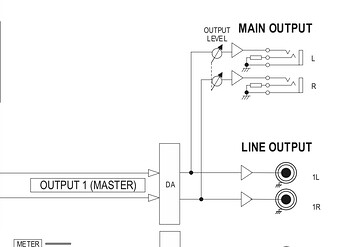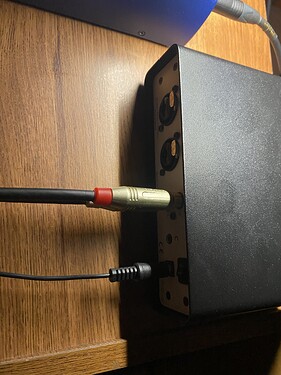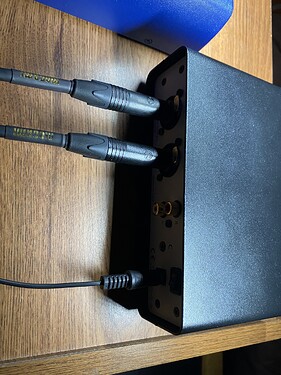I have a replacement coming next week too. Not that I need another amp but the green glow brings me comfort, even after the lego mod.
Is there a consensus on the sweet spot for the gain knob on the RNHP?
I’ve been having success with 12-1 o’clock on Input B but I’m not done testing. I also feel it might be different on Input A.
And no, it’s not generally “when my headphones are loud enough”. For example if you have a gain stage on your DAC, you can make them “loud enough” at 9 o’clock, 3 o’clock, or anything in between on the RNHP.
I haven’t seen this discussed. Thoughts? Experiences?
I’ve been happy around 10-11pm with inputs A and C; I don’t use B but would set the levels to be around the same for B. I’d use A as a reference as I can’t actually adjust levels there.
A comparison of Input A and Input B on the RNHP with the same DAC and 2 different headphones:
UR24C Output Schematic. A physical knob controls “Output Level”.
![]()
DAC (Fixed Gain, “Line Output”)
→ World’s Best Cables RCA (Mogami 2534 wire)
→ Input B
32 ohm bio-cellulose; listening level @ 9 o’clock
Amp Noise floor audible at 11:30
470 ohm dynamic; listening level @ 11 o’clock
Amp Noise floor audible at 3
![]()
DAC (Variable Gain, “Main Output”)
→ Mogami Gold TRS (Mogami 2534 wire)
→ Input A
32 ohm bio-cellulose; Sweet Spot @ 12-2 o’clock
Amp Noise floor audible at 3
470 ohm dynamic; Sweet Spot @ 2-4 o’clock
No audible amp noise floor(!)
Both headphones performed dramatically better when the amp went into its Sweet Spot. More grip, more control, better imaging, more micro and macro detail, higher tonal density… What’s more is that each headphone came into its own and had its own individual improvements.
Conclusions:
Input A is better, all other things being equal. It has a sonically blacker background and the amp’s noise floor is always fully beyond its Sweet Spot regardless of headphone.
If you don’t have a DAC capable of controlling the level it puts out, I’m afraid you won’t be getting the most out of the RNHP (or most other high quality amps for that matter). Many DACs put out 2V which is too hot; you don’t want it accounting for that much gain if you’ve got a dedicated amp. You want to give the amp just the right amount of signal to allow it to perform its best.
All the above is even more important for low impedance and sensitive headphones.
My RCA cables are now in the drawer.
FWIW, YMMV
I actually bought the “Rain Rod” version of this amplifier.
My unit is driven by a good 24V Mean Well power supply. The sound is fantastic however my biggest grief about this amp is that it doesnt play well with IEMs. At all volume levels are distinct hiss is present. I was able to stop this from happening by using 3.5mm impedance adapters.
The Rod Rain version of the RNHP needs an earphone with atleast 200 ohm resistance to be noise free. I achieved that by combining impedance adapters. Then I settled on a 75 ohm adapter + ifi earbuddy.
I was interested in trying out the XLR inputs and decided to order a RCA male to xlr male cable on amazon. This went well and I have to say that the sound became clearer but also less loud when i switched to input A.
My desktop setup consists of a DAC that feeds into a tube pre-amp and this amp then feeds into a hybrid amp and finally into my RNHP unit.
It is such a downside that this amp doesnt play well with in Ears and has it’s power switch on the backside.
Rain Rod? XD
I guess that’s a clone of the clone. But I’m not surprised at all to hear it doesn’t work well with IEMs. The RNHP didn’t work well either and officially requires a min impedance of 16 ohms.
You’re feeding the output of the hybrid amp to the RNHP clone? Or is it also a preamp? I would check to see how the clone amp performs without the tubes. The noise floor shouldn’t be that bad lol
Xduoo mt-603 to Xduoo mt-602 to the rod rain rnhp.
I just really like the sound that a tube preamp can give you.


